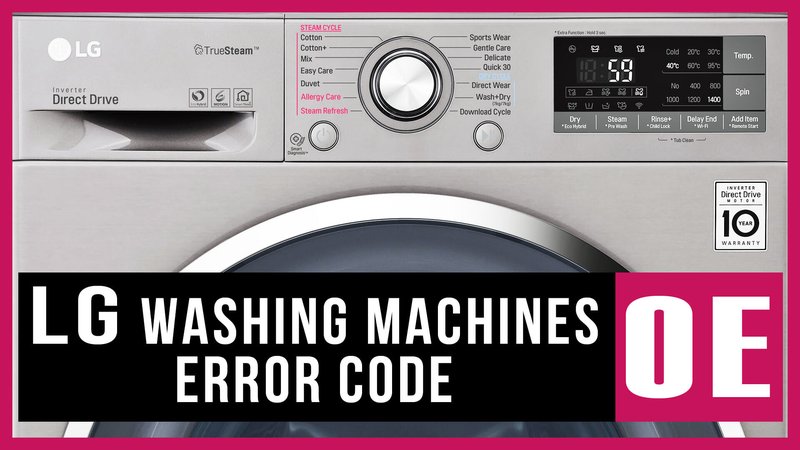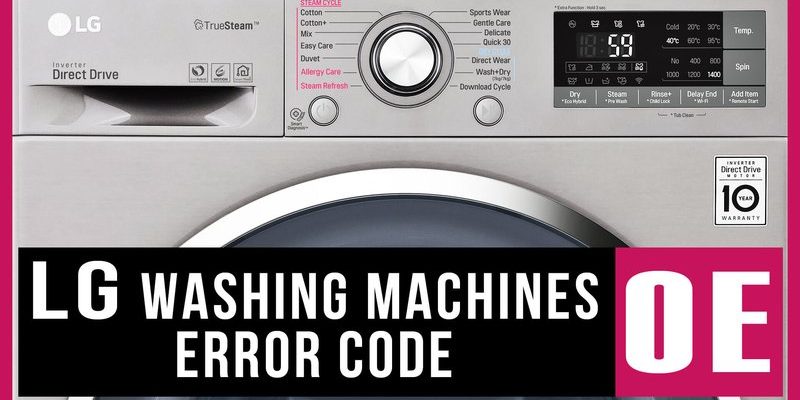
So, what exactly causes the E2 error? Essentially, it occurs when your washing machine can’t drain water properly, much like a bathtub that won’t empty because there’s a blockage. But fear not! Just as you would clear out the drain in your sink, you can address this issue with a bit of troubleshooting and some preventative measures. By learning what causes the E2 error and how to avoid it, you can keep your machine running smoothly and extend its lifespan.
Understanding Error Code E2
The E2 error code corresponds to a drainage problem within your LG washing machine. Imagine your washing machine as a large bathtub. After the wash cycle, the water needs to drain out completely to ensure your clothes aren’t left soaking wet. This process is usually seamless, thanks to the machine’s drain pump and hoses. However, if there’s an obstruction, the water can’t escape. This blockage could be due to lint, debris, or even a kinked hose.
Think about trying to drink from a straw with a piece of paper stuck inside. The suction becomes difficult, if not impossible, right? Similarly, when something is blocking the water’s path out of your washing machine, it struggles to drain. Recognizing the signs early, like the E2 error, can prevent a minor problem from becoming a major headache.
Next time, if you notice that your clothes are wetter than usual after a cycle or hear unusual sounds from the drain pump, those are hints that something might be obstructing the flow. Addressing these signs promptly can keep the E2 error at bay. So what should you do if the error pops up? Don’t worry; there are steps to tackle it, and more importantly, ways to prevent it from recurring.
Common Causes of the E2 Error Code
So, what might cause your washing machine to display the E2 error code? The most typical culprits are blockages in the drain hose or pump filter. Over time, small items like coins, hairpins, or lint can accumulate and obstruct these pathways. It’s akin to how leaves can clog a drainpipe in your backyard, leading to overflow and mess.
Another reason might be a kinked or improperly installed drain hose. If your machine’s drain hose is twisted or loops awkwardly, it can impede the flow of water. Imagine trying to sip through a bent straw — not much liquid gets through, right? Similarly, a kinked hose forces your washing machine to work harder to drain water, often triggering the E2 error.
Sometimes, it might even be a faulty pump. If all the visible components seem fine, yet the error persists, the internal pump could be struggling due to wear and tear. Regular maintenance and conscious operations can keep these causes in check. For instance, always ensure you’re using the right detergent and not overloading the machine, as these habits can contribute to blockages and drainage issues.
Steps to Handle and Prevent the E2 Error
Here’s the deal — addressing the E2 error isn’t as daunting as it seems. First, check the drain hose for any visible blockages or kinks. A quick fix on these parts can sometimes resolve the problem. Next, locate the pump filter (usually accessible from the front of the machine) and clean out any debris. It’s like cleaning the lint trap in your dryer; neglecting it can lead to bigger problems.
Preventative maintenance is your best friend here. Regularly inspect the filter and hose, perhaps once a month, to clear out any buildup. Also, be mindful of the items you put in the wash. Ensure nothing is left in pockets and that items like bras with wires are washed in protective bags to prevent them from causing blockages.
Consider running a maintenance cycle every so often with a washing machine cleaner to break down any detergent buildup. These small steps can go a long way in preventing the E2 error from disrupting your laundry routine. If you ever feel stuck, remember that calling a professional is always a good option.
Building a Routine to Avoid Future Issues
Prevention, as they say, is better than cure. Adopting a few simple habits can keep the E2 error from returning. Start by creating a checklist of pre-laundry tasks: checking garment pockets, ensuring the drum isn’t overloaded, and using the correct amount of detergent. Think of this routine like brushing teeth before bedtime; it’s easy to skip but makes a world of difference in the long run.
Additionally, familiarize yourself with your washing machine’s manual — it’s more than just a set of instructions. It’s a guide to keeping your appliance running smoothly. Many users overlook this resource, but it contains valuable information on maintaining optimal performance and handling errors.
Finally, keep an ear out for any unusual noises during wash cycles. Odd sounds can be the machine’s way of alerting you to potential issues before they escalate. Early detection and regular maintenance will not only prevent the E2 error but also make sure your LG washing machine stays in tip-top shape for years to come. With these strategies, you’ll be spinning clothes, not your wheels, when it comes to laundry!
